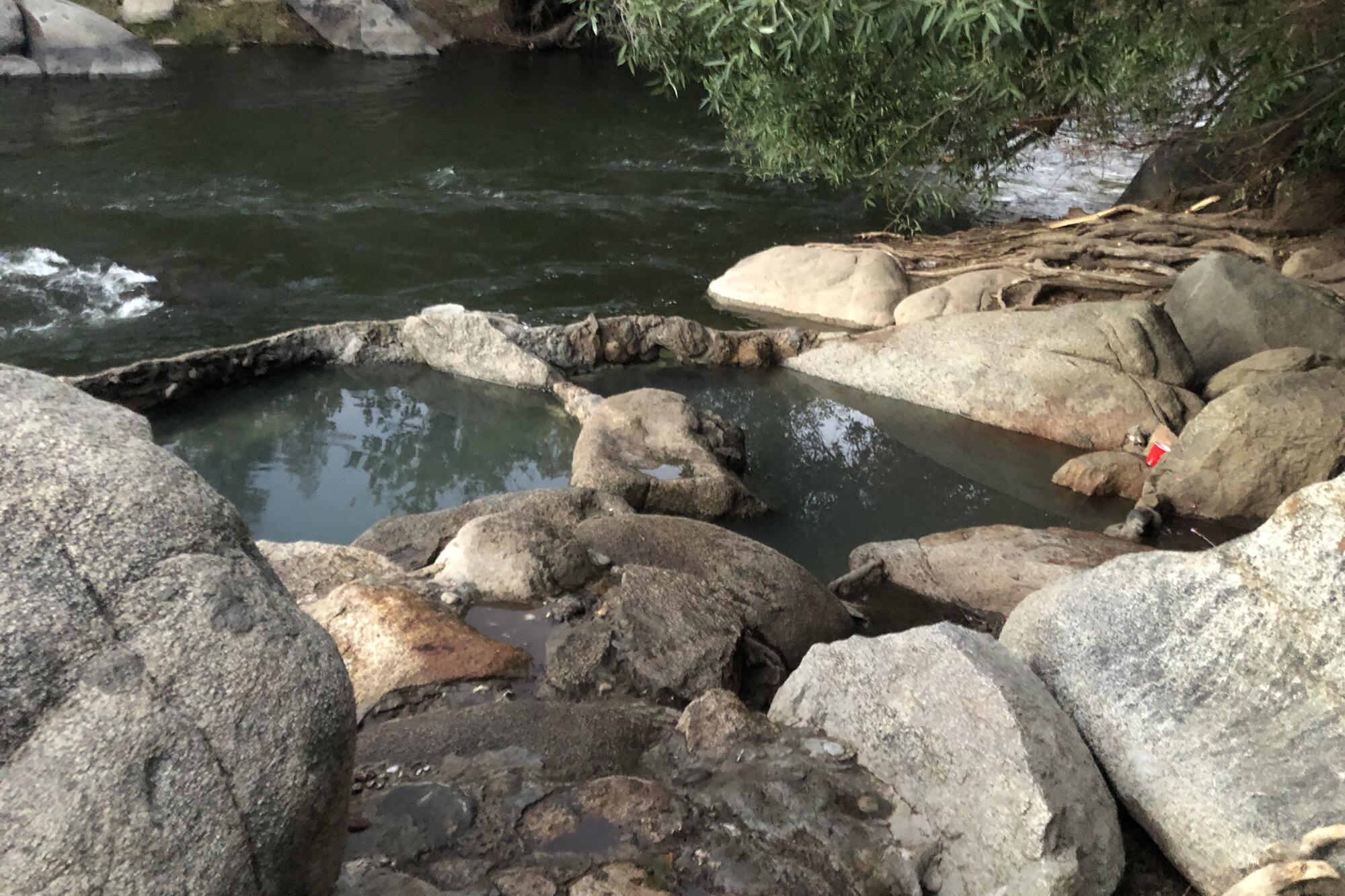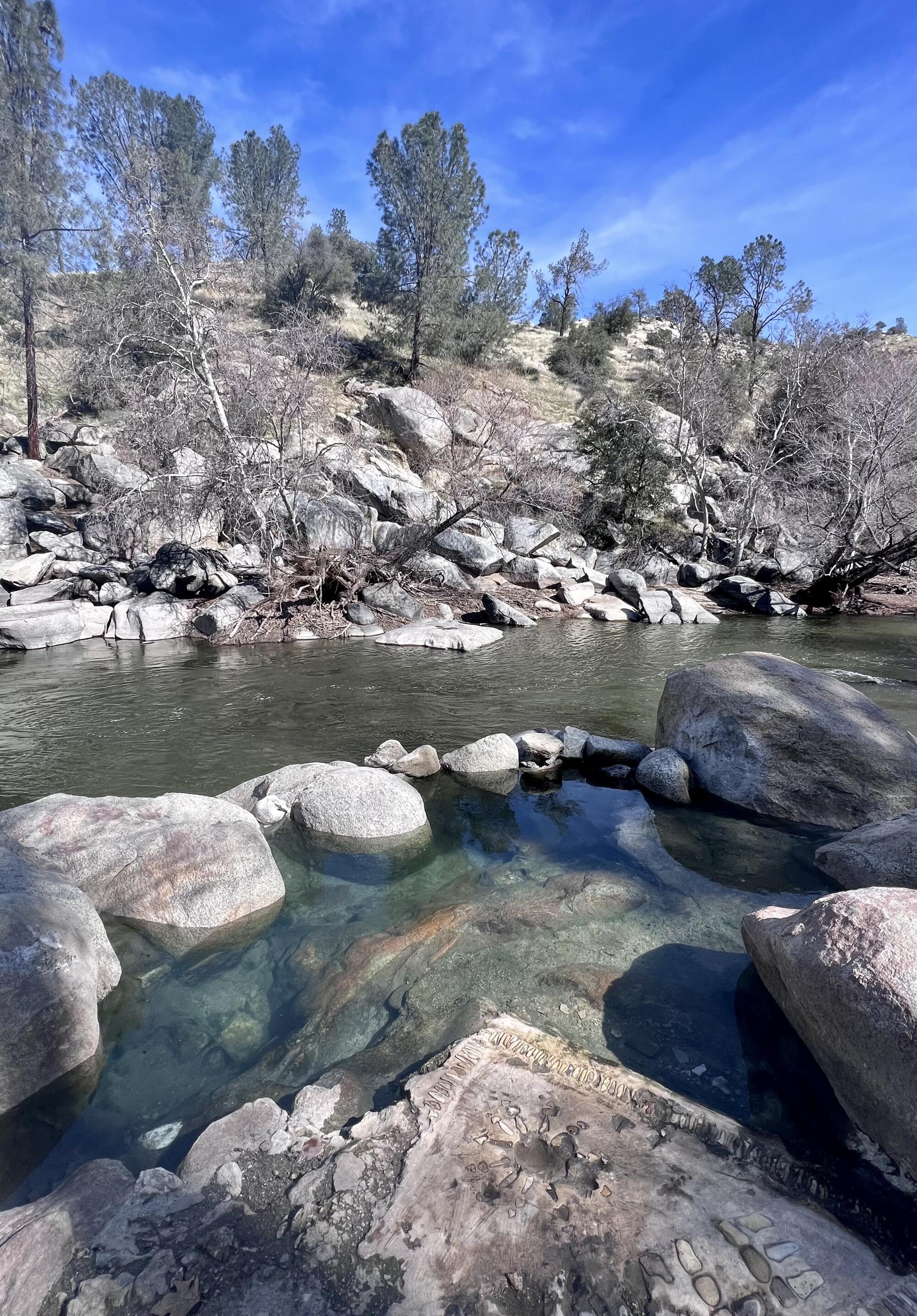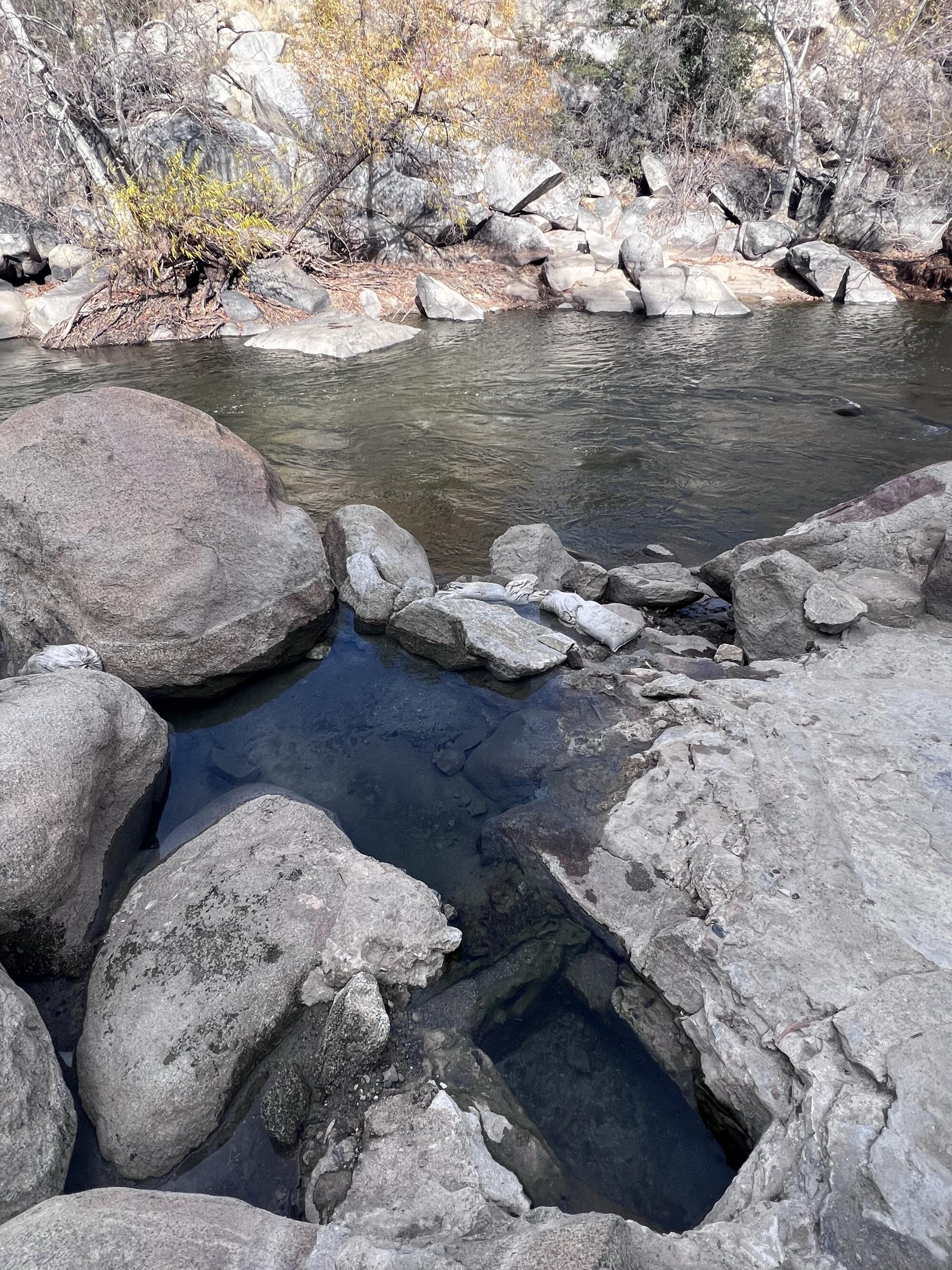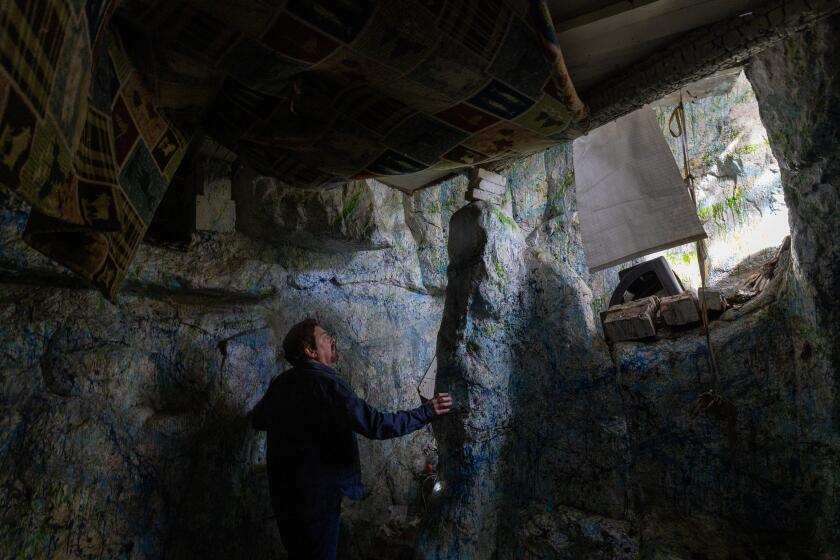
- Share via
The first time David Carman submerged himself in the steamy waters of a Miracle Hot Springs soaking tub, the experience blew his teenage mind.
What followed was a life-long devotion to the soothing, spring-fed baths snuggled against the banks of the Kern River, about six miles downstream from Lake Isabella, in the Sequoia National Forest.
“Those hot springs are healing,” insists Carman, now in his 50s.
But the rock-and-mortar tubs are a chronic source of frustration for the U.S. Forest Service, which has demolished the illegally built structures several times, only to see them quickly replaced. Now, after the discovery of two dead bodies and a bloodied hot tub, park authorities have deemed the beloved Kern County springs off-limits and have threatened to ticket trespassers.
While park authorities insist the closure is necessary to ensure public health and safety, the decision has sparked outrage among devotees of the hot springs, who have accused the federal government of overstepping its authority and failing to include them in the decision. Among those who previously chastised the Forest Service for its “unilateral” actions is former House Speaker Kevin McCarthy.
Community groups are demanding that the hot springs be reopened, but park managers say it would be irresponsible for them to turn a blind eye to the potential dangers, which include structural hazards and harm to the environment, as well as illicit activity. Those dangers increased with the surge in park attendance that accompanied the COVID-19 pandemic and continues today, officials say.
“If the Forest Service took no action, when we had such a small area — like, we’re talking about an area that’s the size of two living rooms — and you have multiple fatalities, I think that people would be upset,” said U.S. Forest Service District Ranger Al Watson.
Everybody loves Tripod the three-legged coyote, but High Desert locals say that visitors are spoiling the beast with handouts and causing a dangerous situation.
Carman, president of the Miracle Hot Springs Conservancy — a nonprofit dedicated to stewarding the resource — is among those advocating for continued public access to the popular destination. He argues that the physical and psychological benefits of the hot springs outweigh the perceived risks, and that the community shouldn’t pay the price for accidents or the bad decisions of individuals.
He said people die on public land all the time, without the incidents leading to long-term closures. For example, between 2013 and 2023, 152 people perished at Yosemite National Park, making it the second deadliest national park, according to a recent study. Yet crowds continue to pour in, and climbers still scale the sheer walls of El Capitan.

Watson maintains that a crucial difference is that the soaking tubs are man-made structures that were built without authorization on Forest Service land. Overseeing them is a job the agency didn’t ask for.
The hot springs are located between Bakersfield and Kernville, along a bank of the Kern River that is lined with leafy trees and boulders. The crudely built soaking tubs are designed to capture the scorching water that spurts from the ancient springs — a dramatic contrast to the freezing river.
As the spring water dissolves surrounding rock, it becomes suffused with sulfur, magnesium, iron and borax, according to KernValley.com, a guide to the region. Some believe the mineralized waters can soothe the body and mind.
Over the past decade, the internet catapulted the hot springs to fame, drawing tourists from across California and the globe, according to the conservancy.
The popularity grew during the pandemic, and, some say, the crowds brought trouble. Most visitors were respectful, but some trashed the area, camped illegally or partied with drugs. Others went into the tubs nude, making fellow soakers uncomfortable. Watson alleged even more nefarious activity, including sexual assaults and car break-ins.

Subscribers get exclusive access to this story
We’re offering L.A. Times subscribers special access to our best journalism. Thank you for your support.
Explore more Subscriber Exclusive content.
“It was a big mix, because it was just so nice and popular, it kind of drew everybody in,” said Jake Ballard, a former Kernville resident who used to soak on a near-weekly basis after an intense gym session or rock climb.
Sometimes he witnessed people drinking and smoking weed to the point of visible intoxication.
“Then you mix in the weird characters, and you’re basically like, anything could happen,” he said.
He tried to avoid the area when it was likely to be busy but was drawn to its supposed healing properties. After hopping into a blazing hot pool for a minute or two, he’d plunge into the frigid river, repeating the ritual several times.
“It would just zap my muscles and totally work magic on them,” he said.
Another regular visitor, Andrea Dennison, 28, of Bakersfield said weekends could draw rowdy crowds who blasted loud music.
On one occasion, about a year ago, a group of young men began to circle “like sharks” around Dennison and her girlfriends — who were topless. As the women attempted to make an exit, Dennison slipped on the rocks, and one of the men grabbed her arm, she said. She thanked him for steadying her but then felt him grope her buttocks. She told the man to back off, only to have him grab her arm again. She pulled a knife on him and left the area with her friends.
It wasn’t the only time men overstepped their bounds, she said.
Still, Dennison expressed ambivalence about the hot springs’ closure because “so much good has come out of there.”
“Logically, I think it does make sense for them to be closed,” Dennison said. “But the little earthy part of me doesn’t want them to be.”
Conservationists have been given a chance to purchase a storied 2.4-acre parcel of wild Laurel Canyon, but they need to raise $1 million in 60 days.
Visits to the springs came to a sudden halt Oct. 17, 2022, when authorities discovered a body at the site and blood in the soaking tubs. The Kern County coroner’s office identified the deceased as James Cho, 54, of Torrance and determined that he had succumbed to acute methamphetamine toxicity.
Officials began to remove sections of the tubs to drain the blood, believed to have been the result of Cho hitting his head. During this process, the tubs were determined to be structurally unsafe and were removed completely, Watson said.
The removal infuriated lovers of the hot springs. But early the following year, with the blessing of park officials, they were able to rebuild rudimentary tubs with natural materials at the site, such as sand and river rocks.
Sign up for This Evening's Big Stories
Catch up on the day with the 7 biggest L.A. Times stories in your inbox every weekday evening.
You may occasionally receive promotional content from the Los Angeles Times.
The tubs, however, were inaccessible for at least several months after a series of heavy winter storms and flooding along the Kern River in the spring of 2023 covered the area in water. But river levels eventually dropped, and the area was exposed again, likely in October or November, officials said.
It’s believed that people returned with bags of concrete once the water receded and built sturdier tubs.
Then, on the morning of Feb. 17, a second body was found in one of the reconstructed tubs, the U.S. Forest Service said. The cause of death has not been determined, but the coroner’s office identified the deceased as William Warden Carroll, a 57-year-old from the nearby town of Lake Isabella.

Watson ordered the closure of the hot springs shortly afterward, and officials warned that people found in the area could soon be ticketed.
“With a second death that can be attributed in part to the hot springs, the area will remain closed until a sustainable long-term solution is reached,” Watson said in a Feb. 26 news release.
Watson said he did not know the tubs had been rebuilt until he was informed of the most recent death.
Although the closure order does not include nearby Remington Hot Springs — another site with illegally constructed soaking tubs — it is more difficult to access due to a steep slope.
Experts say the Miracle Hot Springs saga highlights the challenges of balancing public access and public safety.
Zeke J. Williams, a Denver-based attorney specializing in federal public lands law, said closures are frequently issued by Forest Service officials for safety reasons, such as for certain roads during a wildfire. As long as the officials have a rational basis for their decision, regulations tend to support it, he said.
However, the Multiple-Use Sustained-Yield Act of 1960 requires Forest Service officials to balance a variety of uses of the land they manage, including livestock, mining, outdoor recreation and wilderness preservation, said Williams, who is not involved in the matter at Miracle Hot Springs.
“It’s easy to say, ‘Balance all these uses.’ It’s really hard to do it in practice,” Williams said. What’s happening at the hot springs, he said, sounds like “the consequence of how hard it is to balance competing uses and ideas about how our federal Forest Service land should be used and enjoyed.”
He added that no one has the right to build structures on Forest Service land unless they obtain a special-use permit from the agency. That includes guerrilla hot tubs.
Environmentalists are calling for federal intervention after 4,000 threatened fish were killed by pumps operated by the State Water Project and the Central Valley Project.
Prior to Watson taking over the Kern River Ranger District — which spans 663,000 acres — in 2013, the Forest Service periodically removed the tubs, he said. Community members would rebuild them weeks or months later, creating a cycle of creation and destruction.
“I saw a need for change,” Watson said. His decision to create a sustainable management plan led to the advent of the Hot Springs Angels, a volunteer group that helps maintain the springs. For several years, the recent iteration of the tubs remained intact — until the fatality in 2022.
Community meetings were held at Miracle Hot Springs in late 2022 and early 2023, drawing about 65 people, Watson said. They discussed benefits and challenges of the natural amenity, as well as ways to manage it.
A solution floated was bringing in a concessionaire to maintain the springs on behalf of the Forest Service, potentially charging a fee for entry.
Shortly after those meetings, historic rains flooded the area and submerged the tubs. With the springs inaccessible, the discussion about what to do petered out.
Today, Carman supports the idea of bringing in a concessionaire but insists a shorter-term solution is needed. He worries that the process will be drawn out and believes people need access to the pools in the meantime.
“Closing the hot springs, in my mind, is not an option,” he said.
Toward a more sustainable California
Get Boiling Point, our newsletter exploring climate change, energy and the environment, and become part of the conversation — and the solution.
You may occasionally receive promotional content from the Los Angeles Times.










